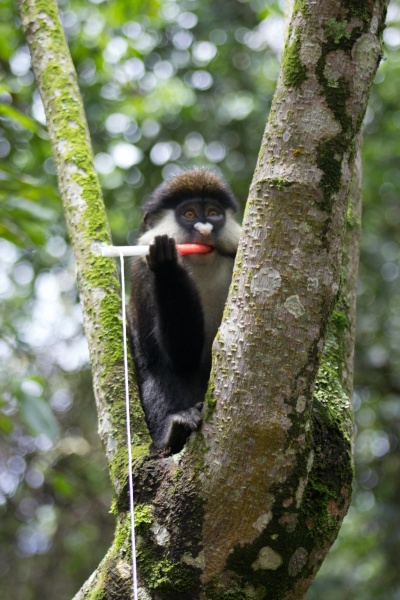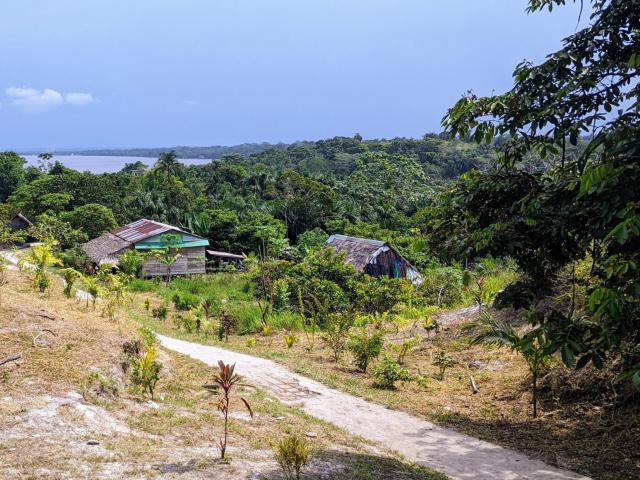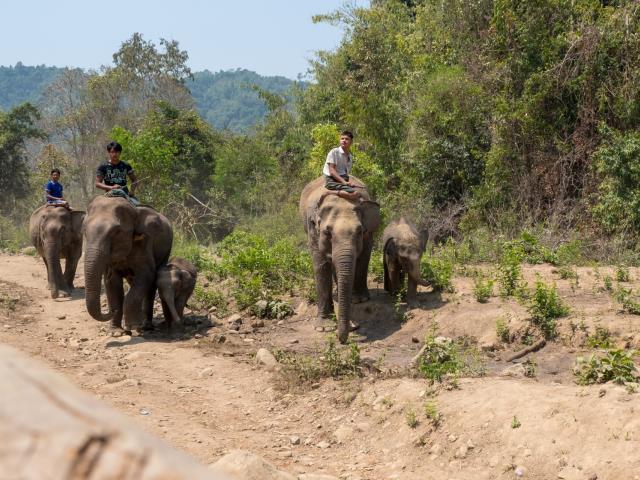
EpiCenter for Emerging Infectious Disease Intelligence
The EpiCenter for Emerging Infectious Disease Intelligence was established in 2020, as a part of the Centers for Research in Emerging Infectious Diseases (CREID) Network. This work is funded by the National Institute of Allergy and Infectious Diseases (NIAID) at the National Institutes of Health (NIH), award U01AI151814.

About
The EpiCenter for Emerging Infectious Disease Intelligence (EpiCenter) brings together a consortium of leading research partners to advance an understanding of viral emergence from wildlife in forests and rapidly urbanizing environments. The work enhances preparedness for disease emergence events in the Congo and Amazon Basin forest regions and supports response efforts at the source of emergence. Our multidisciplinary team has expertise in infectious disease epidemiology, virology, human and animal health, medical entomology, disease modeling, and capacity strengthening. Project activities include integrating human, animal, and vector surveillance data to enable insights into cross-species disease transmission and the ecology and evolution of emerging infectious disease. Our team facilitates collaborative responsiveness to emerging infectious disease risk at the local, regional, and international levels.
Our work focuses on arboviruses, filoviruses, and coronaviruses, as well as newly emerging threats that pose epidemic and pandemic risk. To evaluate disease transmission dynamics at the initial point of emergence in humans, surveillance is being conducted in forest and rural communities where virus spillover initially occurs from contact with wildlife. We will also investigate these viruses in the secondary stages of emergence, in urbanizing areas peripherally connected to forests, where viruses adapt to human-to-human transmission (by direct or vector-borne transmission). As part of the CREID Network, the EpiCenter will advance an understanding of ecological, immunological, and evolutionary mechanisms driving cross-species transmission dynamics of emerging viral threats. We will optimize innovative strategies to strengthen infectious disease research and improve preparedness to combat emerging diseases.
Where We’re Working
Our research sites span two distinct, but strategically-chosen ecosystems in which to investigate zoonotic disease emergence and transmission dynamics. The Congo Basin forest perimeter in Uganda and the Amazon Basin forest perimeter of Peru have a history of emerging and re-emerging infectious diseases, and are hotspots of biodiversity where zoonotic spillover can first emerge.
Environmental change in these biodiverse regions facilitates animal-human contact and adaptation of pathogens into new hosts. Species living near forest perimeters, such as primates and bats, can host viruses capable of spreading to humans. Mosquitoes can act as vectors to spread infection between humans and animals that may not have otherwise encountered each other. Research on evolution and adaptation of viral threats in these regions will shed new light on infectious disease dynamics along the spectrum of spillover and spread.


Featured Research

Highly pathogenic avian influenza A (H5N1) in marine mammals and seabirds in Peru
Leguia M, Garcia-Glaessner A, Muñoz-Saavedra B, Juarez D, Barrera P, Calvo-Mac C, et al. Nature Communications 2023;14:5489.

Predicting the potential for zoonotic transmission and host associations for novel viruses
Pandit PS, Anthony SJ, Goldstein T, Olival KJ, et al. Communications Biology. 2022; 5:844.

Exposure to diverse sarbecoviruses indicates frequent zoonotic spillover in human communities interacting with wildlife
Evans TS, Tan CW, Aung O, Phyu S, Lin H, Coffey LL, et al. International Journal of Infectious Diseases 2023;131:57–64.
Publications
-
Mendoza AP, Muñoz-Maceda A, Ghersi BM, De La Puente M, Zariquiey C, Cavero N, et al. Diversity and prevalence of zoonotic infections at the animal-human interface of primate trafficking in Peru. PLoS ONE. 2024 Feb 7;19(2):e0287893.
https://dx.plos.org/10.1371/journal.pone.0287893 -
National Academies of Sciences, Engineering, and Medicine. Wastewater-based Disease Surveillance for Public Health Action. Washington (DC): National Academies Press (US); 2023.
https://doi.org/10.17226/26767 -
Leguia M, Garcia-Glaessner A, Muñoz-Saavedra B, Juarez D, Barrera P, Calvo-Mac C, et al. Highly pathogenic avian influenza A (H5N1) in marine mammals and seabirds in Peru. Nature Communications 2023;14:5489. https://doi.org/10.1038/s41467-023-41182-0
- Lambrechts L, Reiner RC, Briesemeister MV, Barrera P, Long KC, Elson WH, et al. Direct mosquito feedings on dengue-2 virus-infected people reveal dynamics of human infectiousness. PLoS Negl Trop Dis 2023;17:e0011593. https://doi.org/10.1371/journal.pntd.0011593
- Johnson CK, Freeman JME, Smiley Evans T, Montecino-Latorre D, Uhart MM. Chapter 25. Emerging Coronaviruses: A One Health Harbinger. In: Jessup DA, Radcliffe RW, editors. Wildlife Disease and Health in Conservation, Johns Hopkins University Press; 2023. https://doi.org/10.56021/9781421446745
- Bisia M, Montenegro-Quinoñez CA, Dambach P, Deckert A, Horstick O, Kolimenakis A, et al. Secondary vectors of Zika Virus, a systematic review of laboratory vector competence studies. PLoS Negl Trop Dis 2023;17:e0011591. https://doi.org/10.1371/journal.pntd.0011591
- Astete H, Briesemeister V, Campos C, Puertas A, Scott TW, López-Sifuentes V, et al. Evaluation of “Caserotek” a low cost and effective artificial blood-feeding device for mosquitoes. PLOS Neglected Tropical Diseases 2023;17:e0011563. https://doi.org/10.1371/journal.pntd.0011563
- Evans TS, Tan CW, Aung O, Phyu S, Lin H, Coffey LL, et al. Exposure to diverse sarbecoviruses indicates frequent zoonotic spillover in human communities interacting with wildlife. International Journal of Infectious Diseases 2023;131:57–64. https://doi.org/10.1016/j.ijid.2023.02.015
- Janko MM, Recalde-Coronel GC, Damasceno CP, Salmón-Mulanovich G, Barbieri AF, Lescano AG, et al. The impact of sustained malaria control in the Loreto region of Peru: a retrospective, observational, spatially-varying interrupted time series analysis of the PAMAFRO program. The Lancet Regional Health - Americas 2023;20:100477. https://doi.org/10.1016/j.lana.2023.100477
- Morrison AC, Paz-Soldan VA, Vazquez-Prokopec GM, Lambrechts L, Elson WH, Barrera P, et al. Quantifying heterogeneities in arbovirus transmission: Description of the rationale and methodology for a prospective longitudinal study of dengue and Zika virus transmission in Iquitos, Peru (2014–2019). PLoS ONE 2023;18:e0273798. https://doi.org/10.1371/journal.pone.0273798
- Smiley Evans T, Lowenstine LJ, Ssebide B, Barry PA, Kinani JF, Nizeyimana F, et al. Simian homologues of human herpesviruses and implications for novel viral introduction to free‐living mountain gorillas. American J Primatol 2023;85. https://doi.org/10.1002/ajp.23439
- Cano-Pérez E, González-Beltrán M, Ampuero JS, Gómez-Camargo D, Morrison AC, Astete H. Prevalence of Mosquito Populations in the Caribbean Region of Colombia with Important Public Health Implications. TropicalMed 2022;8:11. https://doi.org/10.3390/tropicalmed8010011
- Evans TS, Aung O, Cords O, Coffey LL, Wong T, Weiss CM, et al. Sylvatic Transmission of Chikungunya Virus among Nonhuman Primates in Myanmar. Emerging Infectious Diseases 2022;28:2548–51. https://doi.org/10.3201/eid2812.220893
- Sanchez JN, Reyes GA, Martínez‐López B, Johnson CK. Impact of social distancing on early SARS‐CoV‐2 transmission in the United States. Zoonoses and Public Health 2022;69:746–56. https://doi.org/10.1111/zph.12909
- Pandit PS, Anthony SJ, Goldstein T, Olival KJ, Doyle MM, Gardner NR, et al. Predicting the potential for zoonotic transmission and host associations for novel viruses. Commun Biol 2022;5:844. https://doi.org/10.1038/s42003-022-03797-9
- Loyola S, Torre A, Flores-Mendoza C, Kocher C, Salmon-Mulanovich G, Richards AL, et al. Molecular Characterization by Multilocus Sequence Typing and Diversity Analysis of Rickettsia asembonensis in Peru. Vector-Borne and Zoonotic Diseases 2022;22:170–7. https://doi.org/10.1089/vbz.2021.0077
This page is maintained by EpiCenter members, independent of NIH/NIAID.
